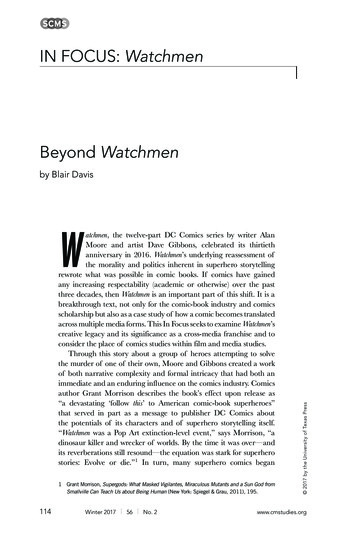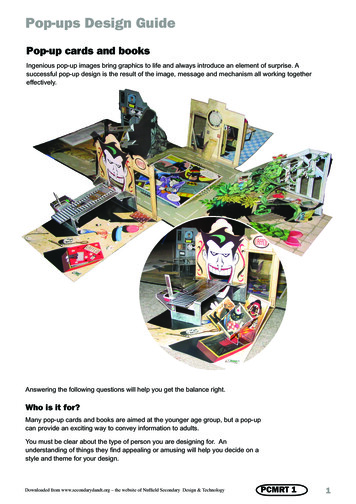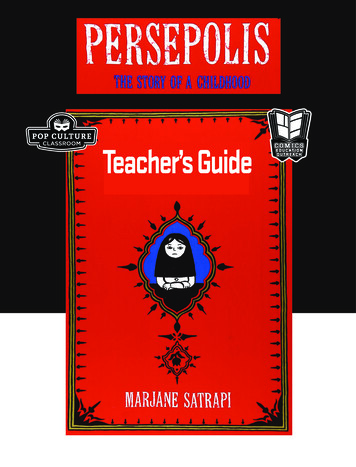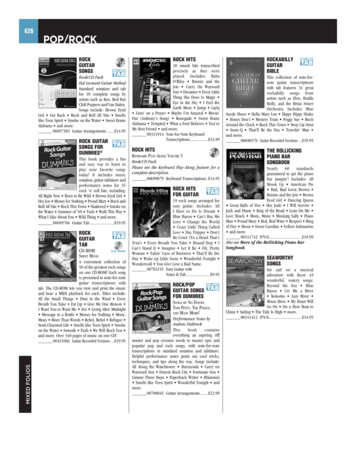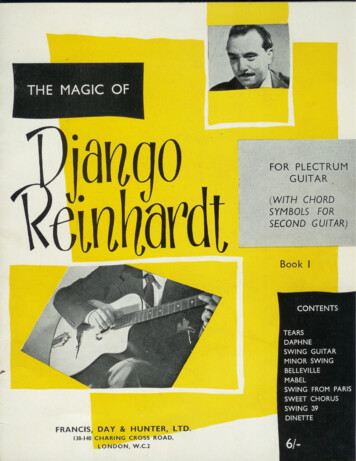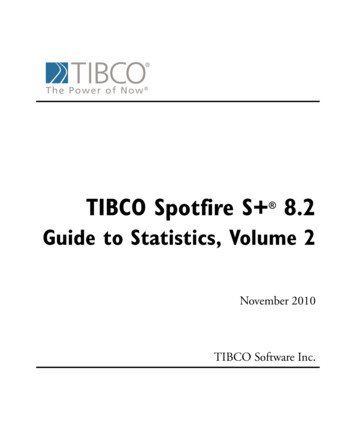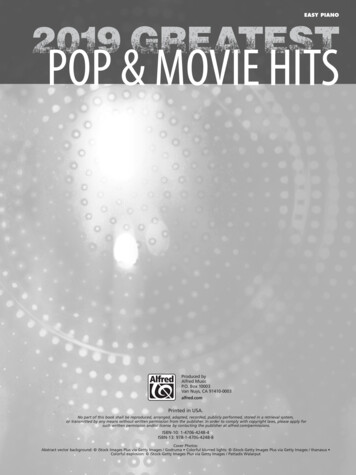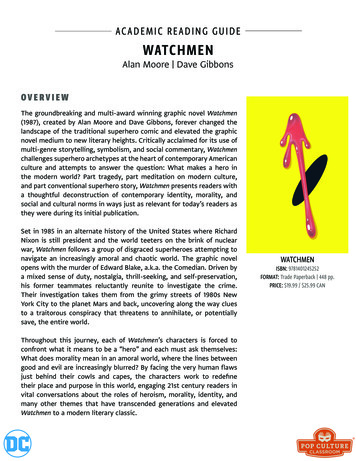
Transcription
ACADEM I C R E A D I N G G U I D EWATCHMENAlan Moore Dave GibbonsOVERVIEWThe groundbreaking and multi-award winning graphic novel Watchmen(1987), created by Alan Moore and Dave Gibbons, forever changed thelandscape of the traditional superhero comic and elevated the graphicnovel medium to new literary heights. Critically acclaimed for its use ofmulti-genre storytelling, symbolism, and social commentary, Watchmenchallenges superhero archetypes at the heart of contemporary Americanculture and attempts to answer the question: What makes a hero inthe modern world? Part tragedy, part meditation on modern culture,and part conventional superhero story, Watchmen presents readers witha thoughtful deconstruction of contemporary identity, morality, andsocial and cultural norms in ways just as relevant for today’s readers asthey were during its initial publication.Set in 1985 in an alternate history of the United States where RichardNixon is still president and the world teeters on the brink of nuclearwar, Watchmen follows a group of disgraced superheroes attempting tonavigate an increasingly amoral and chaotic world. The graphic novelopens with the murder of Edward Blake, a.k.a. the Comedian. Driven bya mixed sense of duty, nostalgia, thrill-seeking, and self-preservation,his former teammates reluctantly reunite to investigate the crime.Their investigation takes them from the grimy streets of 1980s NewYork City to the planet Mars and back, uncovering along the way cluesto a traitorous conspiracy that threatens to annihilate, or potentiallysave, the entire world.Throughout this journey, each of Watchmen’s characters is forced toconfront what it means to be a “hero” and each must ask themselves:What does morality mean in an amoral world, where the lines betweengood and evil are increasingly blurred? By facing the very human flawsjust behind their cowls and capes, the characters work to redefinetheir place and purpose in this world, engaging 21st century readers invital conversations about the roles of heroism, morality, identity, andmany other themes that have transcended generations and elevatedWatchmen to a modern literary classic.WATCHMENISBN: 9781401245252FORMAT: Trade Paperback 448 pp.PRICE: 19.99 / 25.99 CAN
KEY THEMESWar — At the time the book waspublished, the Vietnam War and growingCold War were fresh on the minds ofWatchmen’s authors and citizens acrossthe globe. The book utilizes the themeof constant, pernicious war to show atime where the lines distinguishing goodand evil are blurred and unattainable,and where mutually assured destructionseems ever more likely. Balancedprecariously between violence andredemption, war and peace, justice anddesire, each of the characters muststruggle with the motivations and moralrelativity of war. Thematic symbolsof war throughout the book includethe doomsday clock and other roundobjects, which convey the inevitabilityof war while showing that no “straightlines” exist within the modern world.Public vs. Private — The concept ofpublic and private spaces, and the waysin which they overlap, is a constantthematicreminderthroughoutWatchmen of the ever-shifting barriersbetween our various public and privateidentities. Within the superhero genreand the world of Watchmen, where ourheroes grapple with issues of intimacy,identity, family, and power, thisjuxtaposition between public andprivate shows the intrinsic difficulties ofbeing moral or heroic in an amoral world.Thematic symbols of this dichotomybetween public and private include theheroes’ costumes and Rorschach’s journal.Morality — A central question posed by Watchmen and its characters is: Is there such a thing as right and wrong?Do the ends justify the means? And who decides? Many argue that there is no central moral to the story, and thateach character demonstrates their own definition of morality based on the choices in front of them. Thematicsymbols of morality include the bloody smiley face, Rorschach’s mask, and Dr. Manhattan himself.
KEY SETTINGSNew York City acts as the birthplace of Watchmen’s superheroes in the 1950s, in which first generation of youngand naïve self-proclaimed crime-fighters—the Minutemen—inspired by a new wave of comic book heroes to doncostumes and become heroes themselves. The book opens 30 years later, in a grittier 1980s version of NYC—a placewhere crime is on the rise, nuclear war looms in the collective consciousness, and costumed heroes are outlawed.At the center of this are the Minutemen, once New York City’s most famous heroes but now forced into retirementand spread across the globe.Mars is where Dr. Manhattan, the leastconnected to human nature and the mostsuperpowered character in the story, travelsin order to deal with his increasing distancefrom his own humanness and humanity as awhole. His foreignness from himself and fromothers is perfectly represented on the cold,isolated planet of Mars and the empty, ornatepalaces he builds there.KEY CHARACTERSEach of the characters in Watchmen mustnavigate the conflicting relationshipsbetween their human and heroic identitiesin an increasingly complex world. In doingso, they challenge our preconceived notionsof morality and the archetypal “hero.” Bythe end of Watchmen, each character mustdecide: Is there really such a thing as goodand evil in the first place?Rorschach (Walter Kovacs) is an enigmaticand mentally unstable vigilante who acts asthe narrator of Watchmen. A distorted callbackto the detective comic heroes of the mid20th century, Rorschach operates under astrict vigilante code of ethics that worksto justify his violence and “zero tolerance”policy. Through his journal, a central narrativedevice in the story, readers learn about hisevolving conspiracy theories and effortsto bring his former superhero team backtogether to solve the Comedian’s murder.Edward Blake (The Comedian) is a cigar-chewing, gun-toting, and bloodthirsty manifestationof modern war. An original member of the Minutemen, by the 1970s the Comedian has devolvedinto a corrupt and merciless tool of war for the U.S. government during the Vietnam War. Hissexual assault of Sally Jupiter, the original Silk Spectre, is also a major plot point of the novel.
Hollis T. Mason (First Nite Owl) is a founding member of the Minutemen, the original crime-fighting team thatbegan in the 1940s and 1950s. He has agreed to pass on the Nite Owl heroic title to Dan Dreiberg (the second NiteOwl), and often meets with Dan to reflect on past heroic actions and offer guidance on present heroic challenges.Nostalgic and a bit idealistic, Hollis’ insights provide solid evidence for readers to better understand what itmeant to be a hero in 1950s New York City.Dan Dreiberg (Second Nite Owl) is a wealthy and brooding inventor with a secret lair he has been keepingactive, even after his supposed retirement from the team. Jaded and a bit older, however, Dan is initially notsure he wants to help solve the Comedian’s death. That is, until his fellow superheroine and love interest LaurieJuspeczyk (Silk Spectre) starts to get involved again as well and rethink her own involvement in heroic activities.Laurie Juspeczyk (Second Silk Spectre) is the daughter of Sally Jupiter, the original Silk Spectre. She is the onlyfemale superhero on the reunited team. Despite her role as a hero, she’s still seen as a woman first—as evidencedby her costume design and her complex and fraught relationships with Jon Osterman, Dan Dreiberg, Edward Blakeand other male characters throughout the book.Adrian Veidt (Ozymandias) is a genius billionaire inventor, entrepreneur, fashion model, and media mogul whohas used his heroic identity to create a vast corporate empire. One of the most influential businessmen in theworld, Adrian Veidt is armed with superior intelligence and advanced fighting abilities. Seen by some as a hero andothers as a villain, he seeks out solutions to a potentialnuclear war by rationalizing an “ends justify the means”approach to heroism.Jon Osterman (Dr. Manhattan) is a former physicistwho becomes an all-powerful, practically omniscientbeing thanks to a lab accident. The only member of theteam with “true” superpowers, Dr. Manhattan is partof both the first and second generation of heroes. Ashis powers grow, he helps the United States end thewar in Vietnam and advance its technological presencearound the globe. His efforts to navigate the linesbetween his superpowers, their effects on theworld around him,and the lingeringtraces of his humanity are at theheart of Dr. Manhattan’sstruggle in the graphicnovel.
PRE-READING ACTIVITIES1. Ask students to think about the last time they felt morally challenged and how they solved or didn’tsolve their own challenge.2. Provide students copies of Golden and Silver Age comics to read and discuss how the heroes presentthemselvers in these classic tales. Prompt students to think about heroism and anti-heroism and define eachperspective. Next, ask students to think of the best literary and/or pop culture examples (outside of comics)they have previously read that deal with a hero and an antihero. List examples and relative discussion pointson the board.3. Choose a current event with moral ambiguity and ask students to think about the pros and cons of eachparty’s choices.4. Watch Dr. Strangelove and discuss the Cold War, as well as how authors and artists have used satire toundermine our concepts of morality, confront our cultural anxieties, and interrogate the absurdity of war.5. Using articles and media from the Cuban Missile Crisis standoff, have students analyze what happened,who was at fault, and the varying perspectives on the situation—both at the time and today.DISCUSSION QUESTIONS1. What defines true heroism in Watchmen and how do you know? Are there specific characters or decisionsthat resonate as “heroic” more than others? Does being heroic mean sticking to a certain code, or does itdepend on context? Why or why not?2. What is mutually assured destruction and why is it so critical to understanding heroism and morality inWatchmen?3. Form is key to understanding Watchmen’s many overlapping narratives and characters. Looking specificallyat the funeral sequence at the beginning of chapter 2, have students analyze the parallel stories being toldand discuss how the various forms of visual storytelling by Moore and Gibbons inform the larger themes andmotifs of the story.4. How do the fictional found objects—i.e. the pirate story, journal entries, articles, photos, and others—act to advance the plot and characters throughout the book? Why did Moore and Gibbons decide to includethem in the graphic novel?5. How does Watchmen reflect the elements of an epic and utilize epic conventions to challenge and attimes undermine our conception of superhero archetypes?6. Why do you think the authors used an alternate history as the setting for Watchmen? What social orpolitical commentary do you think they intended to make?7. Why are symbols like the clock, the smiley face, and Rorschach’s mask used so prominently in the book?How do they affect our reading of the story?
PROJECT IDEAS & HISTORICAL CONNECTIONS1. Compare/Contrast: Compare and/or contrast each character’s choices and individual storylinesthroughout Watchmen, reflecting specifically on the moral implications of their choices. Was a character’schoice good or evil? Based on whose judgment? What unexpected complications arose from their choices?Does, as many characters claim, the end justify the means? And who, in the end, is the most “heroic”? Provideclear claims with identifiable evidence (citable text and images) to support your discussions.2. Found Objects: Create a found object collection—composed of fictional and/or real-life objects—as inWatchmen, then use your collection as a foundation for creating your own “fallen” superhero who would fitinto the Watchmen universe. After creating the collection, use the students’ found object collections as anopportunity to explore the symbolic and moral nature of the newly created characters’ choices if they hadbeen faced with circumstances similar to those of the characters in Watchmen.3. Alternate Histories: Research historical events from the book, then compare/contrast with Watchmen’s“alternate histories” of these same events, noting especially where Moore and Gibbons’ stories are true tohistory, and where fiction has blended with fact. Have students analyze and discuss why these changes tohistory were made by the creators, and then create an alternate history of their own that parodies and/orprovides social commentary on an event, place, and/or historical figure.4. Braided Storylines: Have students choose a sequence out of the story that reveals interlaced or framednarrative (where the story goes back and forth between two narratives) or an interaction with the piratecomic, and create their own mimic story of it, using two lines of narrative that happen simultaneously. Howwould they reveal the needed details of each and help the reader to distinguish between the two narratives?5. Rorschach Test: Research the history of the Rorschach test and discuss how and why it plays such animportant role in Watchmen. Why does it appear on the character Rorschach’s mask, and how is it a vital pieceof his character and the book as a whole? Why does the mask seem to change throughout the book? Using areal Rorschach test, make an attempt at psychologizing the character of Walter Kovacs in relation to his alterego, Rorschach, and then speculate about why this particular psychology test represents him.6. The Greco-Roman Gods: Explore the history of Greco-Roman gods, in particular how they changed oncethe Greek gods become Roman gods. The difference between Homer’s pantheon and Ovid’s pantheon arevast. Have students discuss how mythology operates as a central influence on Moore’s book. Which myth(s)influenced Moore in his writing of Watchmen? Why did he select these myths over others as inspiration?FURTH
Watchmen , then use your collection as a foundation for creating your own ÒfallenÓ superhero who would Þt into the Watchmen universe. After creating the collection

